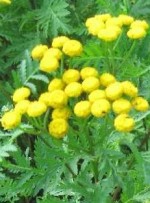 When the colonists came to America they brought various herbs with them. Many were medicinal and very important to their health, or at least they thought so. Some of the herbs they brought survived and did well but others were not happy in their new home and died out. All have long histories and would fit right into an American cottage garden.
When the colonists came to America they brought various herbs with them. Many were medicinal and very important to their health, or at least they thought so. Some of the herbs they brought survived and did well but others were not happy in their new home and died out. All have long histories and would fit right into an American cottage garden.
Here are five medicinal herbs that were grown by Joseph Prentis (1754-1804, a judge in Williamsburg, Virginia.
Elecampane (Inula helenium)
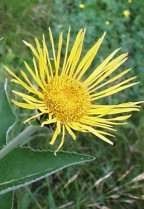 This tall, striking perennial that looks like a double sunflower, dates back to ancient times when it’s root was used to treat digestive problems. It was later used as a remedy for diseases of chest, including coughs, and as a cure for many ailments of horses. This last use gave it the common name “horseheal” and was probably the reason the colonists brought the herb from Europe to America.
This tall, striking perennial that looks like a double sunflower, dates back to ancient times when it’s root was used to treat digestive problems. It was later used as a remedy for diseases of chest, including coughs, and as a cure for many ailments of horses. This last use gave it the common name “horseheal” and was probably the reason the colonists brought the herb from Europe to America.
-
Height: 4-6’
Flowering: Yellow flowers four to five inches in diameter are produced in summer.
Light: Sun-part shade
Soil: Moderately fertile, moist, well-drained
Hardiness: Zones 3-8
Lemon Balm (Melissa officinalis)
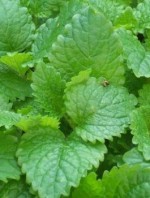 A native of southern Europe and north Africa, lemon balm was the Valium of the colonist’s world, although a whole lot milder. In a land far from home and filled with dangers, a cup of balm tea was a gentle way to relax and regain a sense of well being. Beekeepers used to balm to encourage a new swarm to stay in a hive by rubbing the inside of the hive with it. Unfortunately, the ordinary plant is not very attractive because of its floppy growth habit but variegated varieties are available that make good garden plants.
A native of southern Europe and north Africa, lemon balm was the Valium of the colonist’s world, although a whole lot milder. In a land far from home and filled with dangers, a cup of balm tea was a gentle way to relax and regain a sense of well being. Beekeepers used to balm to encourage a new swarm to stay in a hive by rubbing the inside of the hive with it. Unfortunately, the ordinary plant is not very attractive because of its floppy growth habit but variegated varieties are available that make good garden plants.
-
Height: 2’
Flowering: Two-lipped white or yellowish flowers one half inch long are produced at leaf axils July through September.
Light: Full sun-shade
Soil: Average, well-drained, pH 7.0
Hardness: Zones 4-9
Feverfew (Chrysanthemum parthenium)
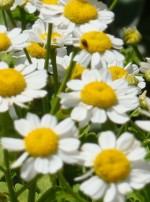 This vigorous perennial (or hardy biennial) is a native of central and southern Europe but has naturalized in North America. As its name suggests, it is effective against fevers; an infusion of its flowers was used to relieve the pain of insect bites, and it was planted around dwellings to purify the atmosphere and ward off disease. In modern times it has been shown to be effective against migraines.
This vigorous perennial (or hardy biennial) is a native of central and southern Europe but has naturalized in North America. As its name suggests, it is effective against fevers; an infusion of its flowers was used to relieve the pain of insect bites, and it was planted around dwellings to purify the atmosphere and ward off disease. In modern times it has been shown to be effective against migraines.
-
Height: 2-3’
Flowering: Small, white, daisy-like flowers bloom at the ends of the stems midsummer through fall.
Light: Full sun-partial shade
Soil: Average, well-drained, pH 6.3
Hardiness: Zones 4-9
Clary Sage (Salvia sclarea)
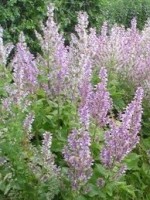 This native of the northern Mediterranean is biennial and has large wrinkled, heart-shaped leaves that clasp the stem. The seeds have a mucilaginous coat that was used to remove grit from the eyes, draw out thorns, and soothe inflammation. The oil was used as a fixative in perfumery and to flavor wines.
This native of the northern Mediterranean is biennial and has large wrinkled, heart-shaped leaves that clasp the stem. The seeds have a mucilaginous coat that was used to remove grit from the eyes, draw out thorns, and soothe inflammation. The oil was used as a fixative in perfumery and to flavor wines.
-
Height: 3’
Flowering: Two lipped pinkish mauve flowers and large pink bracts are carried in whorls in early summer
Light: Full sun
Soil: Moderately rich, well-drained
Hardiness: Zones 6-8
Tansy (Tanacetum vulgare)
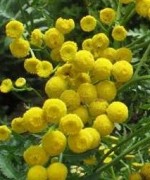 Tansy is a large vigorous perennial native to Europe that has attractive dark green, fernlike leaves and flat clusters of small yellow flowers. The leaves smell like camphor and were scattered over the floor of a room to repell fleas and flies. Tansy tea was used as a stimulant and tonic to reduce fevers and treat various nervous problems. Recent research shows that medicinally effective amounts can cause serious medical problems and death. Tansy was an ingredient in many colonial and 19th century recipes and can be eaten in small amounts without serious ill effects.
Tansy is a large vigorous perennial native to Europe that has attractive dark green, fernlike leaves and flat clusters of small yellow flowers. The leaves smell like camphor and were scattered over the floor of a room to repell fleas and flies. Tansy tea was used as a stimulant and tonic to reduce fevers and treat various nervous problems. Recent research shows that medicinally effective amounts can cause serious medical problems and death. Tansy was an ingredient in many colonial and 19th century recipes and can be eaten in small amounts without serious ill effects.
-
Height: 3-5’
Flowering; Clusters of yellow flower heads are produced in August and September.
Light: Full sun-partial shade
Soil: Average, pH 6.3
Hardiness: Zones 4-8
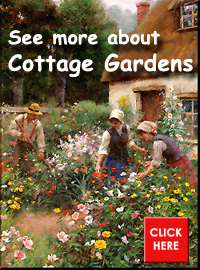 All of these herbs originally came from Europe and were an important part of the colonists’ lives. They grew well in their new environment, so well, in fact, that some are considered weeds. Some are more attractive than others but they all have a history that earns them a spot in an American cottage garden.
All of these herbs originally came from Europe and were an important part of the colonists’ lives. They grew well in their new environment, so well, in fact, that some are considered weeds. Some are more attractive than others but they all have a history that earns them a spot in an American cottage garden.